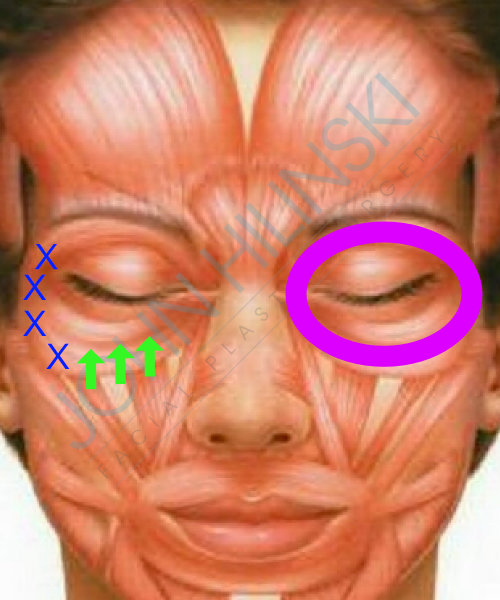 Every once in a while you will hear someone say their under eyes are more wrinkled after getting Botox or Dysport in the crow’s feet. When patients get Botox and Dysport in the crow’s feet area, the intention is to stop that portion of the muscle to reduce animation lines and wrinkles – particularly when people are smiling. This graphic here helps to explain why the area under the eye can appear more wrinkled after crow’s feet Botox and Dysport.
Every once in a while you will hear someone say their under eyes are more wrinkled after getting Botox or Dysport in the crow’s feet. When patients get Botox and Dysport in the crow’s feet area, the intention is to stop that portion of the muscle to reduce animation lines and wrinkles – particularly when people are smiling. This graphic here helps to explain why the area under the eye can appear more wrinkled after crow’s feet Botox and Dysport.
The muscle that is responsible for creating the crow’s feet lines is an oval-shaped muscle called the orbicularis oculi. It is shown here as the purple oval. When this muscle contracts – for example, when you smile – the crow’s feet appear. Botox and Dysport (the X in the adjacent graphic) help by stopping this segment of the oval muscle. Botox and Dysport work by smoothing this area out and reducing formation of the wrinkles. Unfortunately, because it is a continuous, oval muscle, the remainder of it can still contract and move even after the crow’s feet have been injected with Botox and Dysport. Sometimes there can be ‘compensatory’ orbicularis oculi muscle movement under the eye – within the eyelid – that creates unwanted wrinkles in this area (indicated by the green arrows).
The corrective measure for this would be to simply go back to your cosmetic doctor to have them inject a few more Botox or Dysport units into the lower eyelid area. Care should be taken to avoid injecting too much Botox and Dysport in the actual lower eyelid – as this can make the eyelid appear too flaccid or weak. In most cases, the additional Botox and Dysport will help to slow down this undesirable compensatory muscle movement – giving you a smoother, less wrinkled appearance all around the eye.
